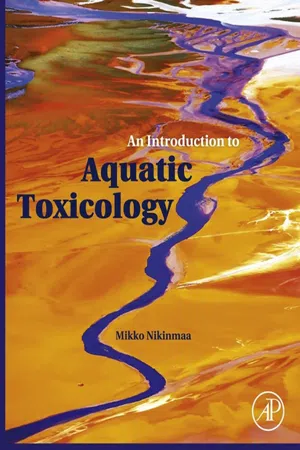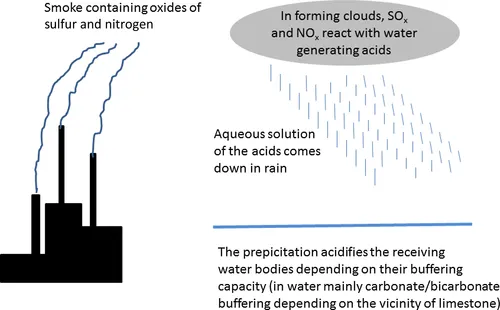
- 252 pages
- English
- ePUB (mobile friendly)
- Available on iOS & Android
eBook - ePub
An Introduction to Aquatic Toxicology
About this book
An Introduction to Aquatic Toxicology is an introductory reference for all aspects of toxicology pertaining to aquatic environments. As water sources diminish, the need to understand the effects that contaminants may have on aquatic organisms and ecosystems increases in importance. This book will provide you with a solid understanding of aquatic toxicology, its past, its cutting-edge present and its likely future.
An Introduction to Aquatic Toxicology will introduce you to the global issue of aquatic contamination, detailing the major sources of contamination, from where they originate, and their effects on aquatic organisms and their environment. State-of-the-art toxicological topics covered include nanotoxicology, toxicogenomics, bioinformatics, transcriptomics, metabolomics, as well as water management and the toxicological effects of major environmental issues such as algal blooms, climate change and ocean acidification.
This book is intended for anyone who wants to know more about the impact of toxicants on aquatic organisms and ecosystems, or to keep up to date with recent and future developments in the field.
- Provides with the latest perspectives on the impacts of toxicants on aquatic environments, such as nanotoxicology, toxicogenomics, ocean acidification and eutrophication
- Offers a complete overview, beginning with the origins of aquatic toxicology and concluding with potential future challenges
- Includes guidance on testing methods and a glossary of aquatic toxicology terms
Frequently asked questions
Yes, you can cancel anytime from the Subscription tab in your account settings on the Perlego website. Your subscription will stay active until the end of your current billing period. Learn how to cancel your subscription.
No, books cannot be downloaded as external files, such as PDFs, for use outside of Perlego. However, you can download books within the Perlego app for offline reading on mobile or tablet. Learn more here.
Perlego offers two plans: Essential and Complete
- Essential is ideal for learners and professionals who enjoy exploring a wide range of subjects. Access the Essential Library with 800,000+ trusted titles and best-sellers across business, personal growth, and the humanities. Includes unlimited reading time and Standard Read Aloud voice.
- Complete: Perfect for advanced learners and researchers needing full, unrestricted access. Unlock 1.4M+ books across hundreds of subjects, including academic and specialized titles. The Complete Plan also includes advanced features like Premium Read Aloud and Research Assistant.
We are an online textbook subscription service, where you can get access to an entire online library for less than the price of a single book per month. With over 1 million books across 1000+ topics, we’ve got you covered! Learn more here.
Look out for the read-aloud symbol on your next book to see if you can listen to it. The read-aloud tool reads text aloud for you, highlighting the text as it is being read. You can pause it, speed it up and slow it down. Learn more here.
Yes! You can use the Perlego app on both iOS or Android devices to read anytime, anywhere — even offline. Perfect for commutes or when you’re on the go.
Please note we cannot support devices running on iOS 13 and Android 7 or earlier. Learn more about using the app.
Please note we cannot support devices running on iOS 13 and Android 7 or earlier. Learn more about using the app.
Yes, you can access An Introduction to Aquatic Toxicology by Mikko Nikinmaa in PDF and/or ePUB format, as well as other popular books in Biological Sciences & Toxicology. We have over one million books available in our catalogue for you to explore.
Information
Chapter 1
Introduction
What is Aquatic Toxicology?
Abstract
The chapter first discusses the history of aquatic contamination, highlighting major cases where aquatic contamination has become an issue and cases where efficient solutions to environmental problems have been reached. Thereafter, the hierarchy of biological functions that can be disturbed by toxicants is briefly introduced. Notably, even when the ultimate goal of toxicological research is to find out how contamination affects an ecosystem, one must remember that the toxicants affect molecular functions of the most sensitive species. Toxicological testing and its uses are then introduced. The principal available aquatic toxicology testing methods, as given by the International Organization for Standardization (ISO) and the Organisation for Economic Co-operation and Development (OECD), are tabulated and the procedure for validating toxicity tests internationally is given. An overview of important issues for aquatic toxicological research in the future is also given.
Keywords
acid rain; paper- and pulp-mill effluent; toxicity test; gene expression; DNA methylation; epigenetics; direct effect; indirect effect; partial-life-cycle test; early-life-stage test; sediment toxicology; oil pollution; sublethal effects1.1. The History of Aquatic Toxicology
As long as human populations remained small, anthropogenic influences on aquatic environments remained small and local. Any effects were in the vicinity of bigger settlements. Probably the first larger-scale aquatic environmental issue resulted from lead water pipes that were used in large Roman towns.
Later, a major aquatic environmental problem was generated when sewage systems were built and people started using toilets (WCs). Consequently, contaminated household water, urine, and feces were disposed of directly to surrounding waters. Although cleaning measures are nowadays taken for most large human settlements, at least in Europe, Japan, North America, and Australia, the eutrophication caused by fertilizing compounds from human settlements, industry, agriculture (including the production of livestock), and aquaculture is a major threat to inland and coastal waters. Because gut bacteria can cause epidemics of intestinal diseases (e.g. cholera), they are still a major component to be determined when water quality criteria are established. The water quality framework is defined for Europe in the Water Policy Framework Directive (WFD) of 26 February 1997, and for the USA in the Clean Water Act and the Water Quality Act, of which the latter is from 1987.
Upon industrialization, acid rain became an issue. By the end of 1800s, coal burning was already causing acid rain and consecutive acidification of poorly buffered rivers and lakes in the British Isles. The immediate solution was to increase the height of chimneys. In the latter part of the twentieth century, this caused oxides of sulfur and nitrogen to be transported from central Europe and Britain to Scandinavia. The acid rain generated came down into poorly buffered streams and lakes in Norway, Sweden, and Finland, where whole fish stocks, especially of salmonids, were wiped out (see Figure 1.1 for the mechanism of water acidification). Similar acidification was observed in some parts of Canada, where it was caused mainly by coal burning in the industrial areas of the USA. As clear environmental disturbances were observed and could be tied to specific polluting sources, in this case sulfur-containing coal (and oil), and as the problems were observed in the aquatic systems of democratic industrialized European and North American countries, it was soon required that, first, the use of fuels containing much sulfur be curbed, second, the use of coal in energy production be decreased, and, third, the smoke be cleaned, removing sulfur from the gases. As a result of these measures, acid rain as an environmental problem is now all but forgotten in Europe and North America. Healthy fish stocks have returned to many formerly acidified lakes. However, globally, acidification of freshwater is of major importance, especially in Asia, where none of the measures that are required in Europe to prevent pollution are so far applied.

Until the latter part of the twentieth century, wastewater was virtually always uncleaned. Whenever the vicinity of effluent pipes became fouled, the solution was to increase the length of the effluent pipe. It was customary to talk about “the self-cleaning capacity of waters.” Because of the idea that effluents could be fed into surrounding waters without cleaning, many major catastrophes occurred. For example, the toxic effects of mercury were seen in the Minamata incident in Japan. Tens or even hundreds of people died of mercury intoxication in 1956, as untreated effluents from a chemical factory were discharged in a bay where local inhabitants took their household water and ate the fish. Although the acute catastrophe could be pinpointed to the single year, the mercury contamination of the bay occurred between 1932 and 1968, and up to the present, around 2000 people have died with mercury intoxication being at least partially responsible, and more than 10,000 people have received some kind of compensation for mercury-intoxication-caused damages. Uncleaned paper- and pulp-mill effluents used to be a major environmental question in western Europe and North America. In the 1960s, the paper- and pulp-mill industry of Sweden and Finland produced an amount of effluent corresponding to the ef...
Table of contents
- Cover image
- Title page
- Table of Contents
- Copyright
- Preface
- Acknowledgments
- Chapter 1. Introduction: What is Aquatic Toxicology?
- Chapter 2. What Causes Aquatic Contamination?
- Chapter 3. Principles of Water Purification
- Chapter 4. Sources and Transport of Chemicals in Aquatic Systems
- Chapter 5. The Most Important Experimental Designs and Organisms in Aquatic Toxicology
- Chapter 6. Factors Affecting the Bioavailability of Chemicals
- Chapter 7. Chemical Uptake by Organisms
- Chapter 8. Chemical Distribution in Organisms
- Chapter 9. Detoxification
- Chapter 10. Excretion of Compounds from Organisms
- Chapter 11. Effects on Organisms
- Chapter 12. Bioindicators and Biomarkers
- Chapter 13. Interactions between Chemicals
- Chapter 14. Acute and Chronic Toxicity
- Chapter 15. Interactions Between Natural Environmental Factors and Toxicity
- Chapter 16. Effects of Chemicals on Aquatic Populations
- Chapter 17. Effects of Chemicals on Aquatic Communities and Ecosystems
- Chapter 18. Modeling Toxicity
- Glossary
- Index